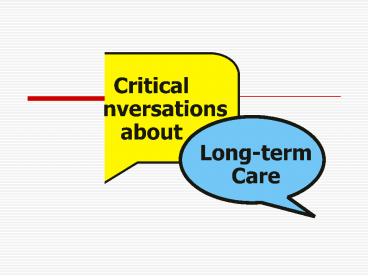Critical Conversations about LongTerm Care - PowerPoint PPT Presentation
1 / 24
Title:
Critical Conversations about LongTerm Care
Description:
Findings of an AARP study Fall 2004. 1,146 respondents over age 60. Can We Talk? ... American Association of Retired Persons. ( January 2005) ... – PowerPoint PPT presentation
Number of Views:303
Avg rating:3.0/5.0
Title: Critical Conversations about LongTerm Care
1
(No Transcript)
2
What is involved in longterm care planning?
- Plan
- Act
- Evaluate
3
Reasons some people say why they were not
prepared for later life
- I never expected to live this long.
- We didnt think it would turn out this way.
- We planned for a healthy retirement.
4
Financing Longterm Care Dilemmas and Decisions
- Major gap in financial planning throughout life
- Gap in laterlife financial security
- Few of us have done any planning
- Wont admit we might be affected personally
5
Financing Longterm CareDilemmas and Decisions
- We think we know more than we do!
- Gaps in knowledge make planning for longterm
care tough!
6
Financing Longterm Care
- Recognize your risk
- Understand costs and implications
- Sort out expectations and goals
- Understand financing alternatives
- Take action now
7
Longterm Care
- Help with daily living activities and remaining
independent - Wide range of personal, social and medical
services - Provided in a variety of settings
8
Most who need longterm care
- Live in their own homes
- Receive unpaid caregiving from family/friends
- Overestimate the chance of needing nursing home
stay - Underestimate need for inhome and community
services
9
Whos at risk?
- 57 percent over age 65
- 40 percent below 65 years of age
- 3 percent are children
10
Whos most at risk?
- Individuals 85 years and older
- Individuals with chronic health problems
- Individuals who lack social support and unpaid
caregivers - Women
11
Prevalence of Longterm Care Need
- Age 65 to74
- In community 11 percent
- In institution 1 percent
- Age 75 to 84
- In community 22 percent
- In institution 5 percent
- Age 85
- In community 49 percent
- In institution 21 percent
12
What are the risks?
13
Potential Costs Underestimated
- In-home care
- Degree of need and health status
- Type of service used
- Visiting nurse 100 per visit (Kiplingers,
2004) - Home-health aide 15 or more/hour (Kiplingers,
2004) - Community services
- Adult day care 60/day (15,000/year)
- Assisted living - housing with services (common
meals, housekeeping) in North Dakota rent -
15,720/year basic services - 7,284/year
(NDLTCA, 2005) - Skilled nursing home care
- One month average in U.S. 5,500 (66,000/year)
- (Metropolitan Life Insurance survey, 2003)
- Northeast and West highest
- North Dakota 144.48/day (52,735/year) (NDLTCA,
2005)
14
Sort Out Laterlife Financial Goals and
Expectations
- Multiple/competing goals behind our decisions
- Make goals known
- Goals provide direction
- Goals can be prioritized
15
If I would need longterm care, I would expect
to
- Remain financially independent
- Maintain control of my finances
- Keep my financial affairs private
- Involve family members
- Utilize government services
- Leave an inheritance
16
Oklahoma Longterm Care Survey
- Findings of an AARP study Fall 2004
- 1,146 respondents over age 60
17
Can We Talk?
- Goals can be a common source of conflict
- Between spouses/partners
- Across the generations
- Who needs to be involved?
- Spouse or partner?
- Adult children?
- Identify areas of agreement and/or disagreement
- On the meaning of goals, priorities, concerns
18
Understand Financing Alternatives and Consequences
- No one financial answer
- Laterlife goals should influence which
alternatives are most appropriate - Consider a combination of alternatives
19
Who does
pay for longterm care?
- Income and life savings of elders and family
members - Sell home and use equity
- Unpaid family caregivers provide majority of
longterm care
20
Who pays for longterm care?
- Medical Assistance (Medicaid) is a critical
safety net
21
Who pays for longterm care?
22
Who pays for longterm care?
- Longterm care insurance will pay
- Longterm care insurance is NOT for everyone
23
Why plan now?
- Peace of mind
- More choices and options
- Increases likelihood your goals and wishes will
be followed - Reduces burden for others
- Reduces misunderstandings and conflict
24
References
- American Association of Retired Persons. (January
2005). Oklahoma longterm care A survey of AARP
members. Available from www.aarp.org - Consumer Reports. (November 2003). Do you need
longterm care insurance?, 68(7), 20-24. - Kiplingers Personal Finance. (February 2004). If
your parents need HELP, 58(2), 76-79. - North Dakota Long Term Care Association (January
2005). Issue and Data Book. Available from North
Dakota Long Term Care Association, 1900 11th St.
N., Bismarck, ND 58501. Telephone (701)
222-0660. Web site www.ndltca.org - Stum, M. S. (October 2004). Financing longterm
care A resource for families. Available from
www.financinglongtermcare.umn.edu































